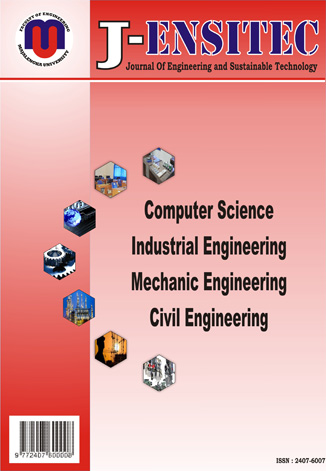ANALISIS KEPUASAN PELANGGAN JASA REPARASI SOUND SYSTEM DENGAN MENGGUNAKAN METODE IMPORTANCE PERFORMANCE ANALISYS (IPA) PADA UD. MBS AUDIO PESANGGARAN BANYUWANGI
DOI:
https://doi.org/10.31949/jensitec.v10i02.8747Abstrak
In facing intense competition in the repair service industry, UD. MBS Audio needs to engage in continuous efforts to enhance service quality and understand the changing dynamics of customer needs. Therefore, the aim of this research is to identify and improve service quality, as well as to design an action plan to enhance services at UD. MBS Audio. This research utilizes the Importance Performance Analysis (IPA) method as a tool to translate customer expectations related to product or service quality. From the calculation results using the IPA method, Quadrant IV is identified as the top priority because it is considered highly important by customers and requires special attention as its performance has not yet reached optimal satisfaction levels. Critical attributes in Quadrant IV include P1, P5, and P10. A thorough evaluation of service quality, divided into four quadrants based on the IPA method, indicates that attributes in Quadrant IV (Top Priority) need continuous improvement to enhance their performance. The company's main focus should be on sustained improvement efforts to enhance the performance of these attributes, such as the cleanliness and tidiness of the facilities provided by UD. MBS Audio, providing satisfactory service results according to customer preferences, and offering guaranteed warranties.
Kata Kunci:
Service Quality, Customer Needs, Importance Performance Analysis (IPA)Unduhan
Referensi
Along, A. (2020). Kualitas Layanan Administrasi Akademik di Politeknik Negeri Pontianak. 6(1), 94–99.
Amin, N. F., Garancang, S., & Abunawas, K. (2023). Konsep Umum Populasi dan Sampel dalam Penelitian. Jurnal Pilar, 14(1), 15–31.
Fajarini, P. A. (2019). Peningkatan Kualitas Layanan Dengan Metode Service Quality Dan Pendekatan Importance Performance Analysis ( Ipa ) ( Studi Kasus : Lynn Hotel Yogyakarta ). Universitas Islam Indonesia.
Fatmawati, N. (2022). Mengenal Lebih Dekat Kebutuhan Pengguna Layanantle. Djkn.Kemenkeu.Go.Id.
Hermanto, H. (2022). Meningkatkan Kepuasan Serta Kepecayaan Pelanggan Dan Mengurangi Tingginya Komplain Menggunka Metode Importance Performance Analysis (IPA). Jurnal Locus Penelitian Dan Pengabdian, 1(9), 757–763. https://doi.org/10.58344/locus.v1i9.740
Indrayana, M., Kelik Fajar Kusuma, & Jono. (2022). Perbaikan Kualitas Pelayanan Hotel Kartika Chandra dengan Metode Servqual Dan Importance Performance Analysis (IPA). Jurnal Rekayasa Industri (JRI), 4(2), 63–79. https://doi.org/10.37631/jri.v4i2.712
Lukita, C., Pranata, S., & Agustin, K. (2020). Metode Servqual Dan Importance Performance Analysis Untuk Analisa Kualitas Layanan Jasa Pendidikan Tinggi Pada Mahasiswa Di Cirebon. Jurnal Digit, 9(2), 167. https://doi.org/10.51920/jd.v9i2.117
Nagara, A. O. A., & Emaputra, A. (2022). Analisis Kepuasan Konsumen terhadap Pelayanan Barbershop dengan Metode Service Quality (Servqual) dan Importance Performance Analysis (IPA) Studi Kasus XYZ Barbershop. Jurnal Rekayasa Industri (JRI), 2(2714–8882).
Pratiwi, I. W. (2018). IMPLEMENTASI IMPORTANCE-PERFORMANCE ANALYSIS (IPA): ANALISIS PREFERENSI KONSUMEN MUDA MIE SETAN MALANG (Studi Kasus Pada Konsumen Muda Mie Setan di Kota Malang). In New England Journal of Medicine (Vol. 372, Issue 2, pp. 2499–2508).
Purwasih, R., Aden, A., & Arofah, I. (2022). Analisis Kepuasan Pengunjung Terhadap Kualitas Pelayanan Dengan Metode Service Quality (Servqual) Dan Importance Performance Analysis (Ipa). MathVision : Jurnal Matematika, 4(1), 7–10. https://doi.org/10.55719/mv.v4i1.308
Rizqiyah, P. E., Subagio, R. T., & Putri, T. E. (2021). Penerapan Metode IPA dan PGCV untuk Mengukur Tingkat Kepuasan Konsumen Coffee Shop. 11(September), 137–151. https://doi.org/10.34010/jati.v11i2
Saputra, B., & Savitri, D. (2020). Penerapan Metode Importance Performance Analysis (Ipa) Untuk Menganalisis Kinerja Suroboyo Bus Sebagai Moda Transportasi Umum Berdasarkan Tingkat Kepuasan Pengguna. 8(3).
Siregar, M. S. A. (2022). Analisa Kualitas Pelayanan menggunakan Metode Importance Performance Analysis. Factory Jurnal Industri, Manajemen Dan Rekayasa Sistem Industri, 1(1), 33–38. https://doi.org/10.56211/factory.v1i1.111
Sitohang, J. N. (2023). Kepuasan Pelanggan Dengan Metode Importance Performance Analysis ( Ipa ) Pada Coffee Shop Teduh Tera Medan. Universitas Medan Area.
Taflikhati, M. N., & Canta, D. S. (2022). Penerapan Metode Importance Performance Analysis untuk Kepuasan Pengguna pada Aplikasi Google Classroom. Jurnal Sosial Teknologi, 2(4), 361–369. https://doi.org/10.59188/jurnalsostech.v2i4.327
Tianto, T. A., Pujiyanto, E., & Rochman, T. (2022). Penentuan Prioritas Usulan Perbaikan Kualitas Layanan Pengguna Aplikasi Ruangguru Dengan Menggunakan Metode Importance Performance Analysis. Performa: Media Ilmiah Teknik Industri, 21(2), 130. https://doi.org/10.20961/performa.21.2.53595
Diterbitkan
Cara Mengutip
Terbitan
Bagian
Lisensi
Hak Cipta (c) 2024 Gian Dwi Prasetyo, Endang Suprihatin, Muhammad Yusuf

Artikel ini berlisensiCreative Commons Attribution-ShareAlike 4.0 International License.
An author who publishes in the J-ENSITEC (Journal of Engineering and Sustainable Technology) agrees to the following terms:
- Author retains the copyright and grants the journal the right of first publication of the work simultaneously licensed under the Creative Commons Attribution-ShareAlike 4.0 License that allows others to share the work with an acknowledgment of the work's authorship and initial publication in this journal
- The author is able to enter into separate, additional contractual arrangements for the non-exclusive distribution of the journal's published version of the work (e.g., post it to an institutional repository or publish it in a book) with the acknowledgment of its initial publication in this journal.
- The author is permitted and encouraged to post his/her work online (e.g., in institutional repositories or on their website) prior to and during the submission process, as it can lead to productive exchanges, as well as earlier and greater citation of the published work







